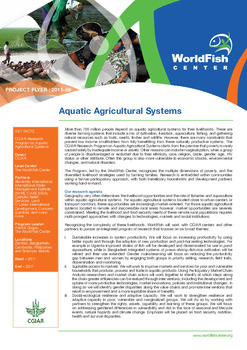Aquatic Agricultural Systems
Abstract
More than 700 million people depend on aquatic agricultural systems for their livelihoods. These are diverse farming systems that include a mix of cultivation, livestock, aquaculture, fishing, and gathering natural resources such as fruits, seeds, timber and wildlife. However, there are many constraints that prevent low income smallholders from fully benefitting from these naturally productive systems. The CGIAR Research Program on Aquatic Agricultural Systems starts from the premise that poverty is rarely caused solely by inadequate income or assets. Other reasons can include marginalization, when a group of people is disadvantaged or excluded due to their ethnicity, race, religion, caste, gender, age, HIV status or other attribute. Often this group is also more vulnerable to economic shocks, environmental changes, and natural disasters. The Program, led by the WorldFish Center, recognizes the multiple dimensions of poverty, and the diversified livelihood strategies used by farming families. Research is embedded within communities using a farmer-participatory approach, with both beneficiary households and development partners working hand-in-hand

